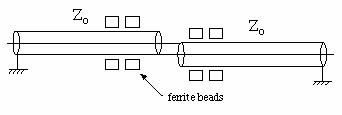It is often necessary to drive resistive loads that have an impedance other than the typical 50Ω output impedance of a pulse source. The simplest solution is mismatch the load to the source. This results in reflections from the junction that go back to the pulse source and may be reflected by it back to the load. Ideally one would build a wide bandwidth transformer at the junction. This can avoid the reflections and also transmit all the available energy to the load. Transformers for pulses can in principal be built, however, there are several limitations that often peclude their use. For an arbitrary impedance ratio it is necessary to use some type of transmission line with a continuously varying geometry (and/or dielectric) such that the impedance changes exponentially from the desired input imedance to the desired output imedance. In addition the rate of change of impedance must be such that the structure is large compared with the wavelengths being transfomed. For high bandwidth systems this can make for a large device and in this case resistive losses may affect the high frequency components. Such transfomers are ideal for narrow band uses especailly where the ratio of imedances to be transformed is such that cable transformers cannot be used or where the shortest possible risetime is requied. Cable transformers offer a method of transforming between specific impedance ratios which depend upon what cable impedances are available. For imedances which are in the ratio of 1:4 cable transfomers can be used simply by combining cables.

However, the isolation of the ends of the lines only lasts for about the round trip time of the cables. To increase this, the two lower lines, in which the input end has to float up, can be covered in ferrite beads to increase the common mode inductance. This will increase the length of pulses for which the transfomer will work. Several hundred nanoseconds is easily achieveable provided the ferrite does not saturate, i.e. so long as the pulse amplitude is not too high. By using cables of a variety of imedances many different schemes can be considered for impedance transfomers. Usually for high ratios there is some combination that is farily close to the desired value. It is important that the currents flowing on the outside of the outer conductor do not mix with those flowing on the inside. For this reason it is usually desirable to use semirigid cables where the skin depth determies the rate of penetration of the currents. With braided cables the braids move from the outside to the inside of the cable along its length and can cause faster penetration of the current. Note that pulse inversion is simply obtained by the following transformer:



